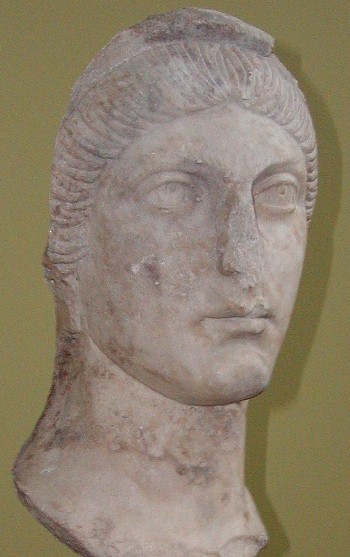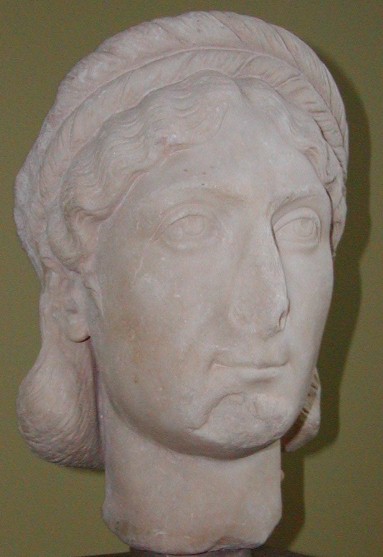2004.07.02
Artifact of Ottopia No. 6

labeled
Aelia Flaccilla
[first] Wife of Theodosius the Great
image: René Seindal 2002.06.30
This piece is labeled correctly. Aelia Flacilla made it a point to always wear her hair in the same fashion as Helena, the proto Christian Empress.
2004.07.02
Artifact of Ottopia No. 7

labeled
Helena
[first] Wife of Constantius Chlorus
Mother of Constantine the Great
image: René Seindal 2002.06.30
This piece is labeled incorrectly, but Eutropia is thrilled nonetheless that a portrait of herself still exists.
| |
2004.07.21 11:29
Re: shining with like...
Eutropia was the wife of Emperor Maximian, who reigned jointly with Emperor Diocletian for 20 years. She was also the mother of the usurper Emperor Maxentius (controlling Italy and North Africa 306-312), and the mother-in-law of Emperor Constantius (whose first wife was Helena and whose first son was Constantine) and the mother-in-law of Constantine. By 326, Eutropia and Helena knew each other for almost fifty years, and were best friends for the at least the last twenty years. For Constantine (and Helena), Eutropia was the font of knowledge about the Empire, especially the Imperial holdings--Eutropia and Helena also shared a keen interest in architecture.
In the coming days Eutropia again demonstrates her remarkable (shrewd political) resourcefulness, for example, issuing a law of silence would have never occurred to Constantine were it not for her suggestion.
The spiral columns were not carved specifically for the new Basilica of St. Peter, rather they were taken from two quondam structures. Scholars today do not know where the columns came from exactly, and it is thanks to The Life of Silvester within the Liber Pontificalis that we at least know they came from Greece. The huge bronze columns of the baldechin (by Bernini) presently at St. Peter's are based on the original (much smaller) spiral columns. The original columns still exist at St. Peter's, where four pairs of them frame to upper niches of the four main supports of the dome respectively.
Rubens depicted the spiral columns within a select group of paintings and tapestry designs, hence "The Marriage of Twisted and Column"--Eutropia's and Ruben's paper for the forthcoming Horace Trumbauer Architecture Fan Club Convention.
2004.07.23 11:07
Mediterranean travel time ?
I have a specific question regarding sea going travel time.
Does anyone here have an idea as to the (average) length of time it took for a ship to travel from Carthage to today's Naples in July 326AD?
2004.07.23 12:37
According to Charlesworth:
- from Naples to Selinous: ~36 hours
- from there to Clupea (Qalibiyah): ~60 hours
Pliny is mentioning an exceptional travel in 48 hours from Africa to Rome.
As winds are rather regulars in July, I would say, more or less, 4 days (72 hours) from Carthage to Naples. Anyhow there are 300 nautical miles between these 2 cities and till XIXth century the navigation medium speed was 4 knots i.e. 75 hours.
(Yesterday, I traveled 500 miles from Patras to Ancona in 20 hours)
Christos Nüssli
-----
2004.07.23 12:42
Galley or sails?
A lot of work has been done on Venetian galleys & distances. It was possible, with adequate motivation, to get from the tip of Southern Greece to Venice in a galley in a week.
DW Diana Wright
-----
2004.07.23 13:43
I see in Piganiol's _L'Empire chrétien_, p. 318, this sentence : "la durée des trajets était très irrégulière, on nous parle de 30 jours pour aller de Marseille à Alexandrie, 5 jours de Narbonne à Carthage". Alas, Piganiol does not give his sources. I think that the journey of 30 days was a coastal shipping one, stopping in each port. For Carthage to Naples, I would say (this is just a conjecture) 3 or 4 days (Carthage-south Sicily, south Sicily-north Sicily or some place in Calabria, Calabria-Naples).
Best.
Pierre-Louis Malosse
| |
2004.07.26 18:34
suicide reenactment
So when did Fausta commit suicide? Was it really on her husband's 20th anniversary as Roman emperor and within 24 hours of her mother-in-law's death?
Last night between 8 and 8:30 I received a phone call from someone I hadn't seen or heard from in over half a year--a crying voice, "I feel horrible. I'd like to commit suicide."
Constantine's favorite joke at the 2004 Vicennalia reenactment: "At least in Istanbul I can still get a decent bath."
2004.08.13 13:57
Re: Is Bonsai an art?
Flavia Maxima Fausta committed suicide 25 July 326
2004.08.19 14:43
your destination please
After 1611 years Olympic Games return to Olympia, on the feast of St. Helena, with the first female athletes to perform there ever.
"Otto (who is now married to the quondam daughter-in-law of Theodosius, the emperor who closed the Olympic Games in 393), notice how the bodies of the shot putters twist like a fanciful column just before they execute their throw."
"You're not telling me that that..."
"Well, we did own the House of Nero there, and the columns are gorgeous, and Eutropia thought it would be wonderful for columns from Nero's Olympia House to then move to Nero's Garden in Rome."
"What's that Piranesi?"
"If you look closely at the Ichnographia Campi Martii, you'll see that I hinted as much."
"Oh, Giovanni Battista, you're such a precursor."
2004.09.14 12:18
Holy Cross Day - 14 September 325
I remain curious of a combined history of the 'authentic' and the 'legendary'.
"It is long believed by native Christians in the Near East that Helena announced her discovery of the True Cross by means of a relay of bonfires. The late Professor Hitti, a native of Lebanon, reports that "native Christians, particularly in Lebanon, still celebrate on September 14 a feast with bonfires reenacting Helena's traditional announcement of the discovery to her son at Constantinople by means of bonfires from hilltop to hilltop." Professors Hitti's report is based on personal observation, one may assume, and has been independently verified."
--Hans A. Pohlsander, Helena: Empress and Saint, page 199.
According to Timothy D. Barnes, The New Empire of Diocletian and Constantine, Constantine resided at Nicomedia (today's Izmit, Turkey, not far from Istanbul) from 25 July 325 to circa 15 September 325. This chronology is based on passages in the Codex Theodosius. (footnote 126, p. 76: ...Constantine was still in or near Nicomedia when he exiled Eusebius of Nicomedia, "three months" after the Council of Nicaea.)
| |
2004.09.23 13:34
Happy Birthday Helena Augusta
According to the latest (and most elaborate) legend, Helena died just a couple of months before what would have been her 80th birthday, 23 September 326.
"What a nice manifestation of 1758th birthday presence."
Was Eutropia at Trier on 23 September 326? Is that when she (metabolically) gave orders for the destruction of the Imperial palace there to then create the enormous twin basilica in its place?
"Perhaps Constantine should have mentioned that I didn't send the letter about Mamre from Mamre. Perhaps Constantine knew he was 'oaking' at the expense of modern doubters."
2004.11.29 15:40
Eutropia's dates
12 November 328 death of Eutropia
12 November 2004 death of open exchange at design-l
26 November 248 birth of Eutropia
26 November 2004 birth of design-l.v2
Or are Eutropia's birth and death dates inverted?
2004.12.07 12:13
Re: Fwd: phrasing
For many centuries now, Eutropia celebrates her deathday (12 November) with Pope Martin I (saint and martyr--feastday 12 November). He died in exile because wouldn't agree with an imperial law of silence which was to shut down all discussion regarding the heresy that denied that Christ had a human will--Monothelism.
So many highlights of 2004 to remember, like the great column of fire 13 February. Are they still camping at Mount St. Helens waiting for the next big blast? Did you know Jim Williams restored (mostly with his own two hands) what might just be the oldest house on St. Helena Island, SC? But there's still more to come, not least Silvester's and Melania's always last minute party.
2005.02.22 14:20
Eutropia is a Syrian, you know
So who is Eutropia?
The wife of Maximian
The stepmother of Theodora
The mother of Maxentius
The mother of Fausta
The stepmother-in-law of Constantius (the father of Constantine)
The mother-in-law of Constantine
The stepgrandmother of the six childern of Constantius and Theodora
The grandmother of the five childern of Constantine and Fausta
The best friend of Flavia Julia Helena Augusta
The person responsible for the building of the first Christian church at the Oak of Mamre
| |
2005.02.25 11:49
Re: [dis]content .1
One flaw in architecture culture I'd like to see fixed is for 'history' to portray late Roman architecture and early Christian architecture within at least the same 'chapter'. The two 'styles' really played an integral role with each other, and that 'history' isn't even addressed, let along recognized.
Anyway, since it's Breaking The Silence Day, here's to everyone now knowing that Constantine has an older half-sister via his mother. By the time they met Eutropia in Palmyra, Maximian, Helena, Theodora, Constantius and Constantine were already a tight little bunch. Theodora was immediately enthralled with Eutropia, and a wonderful 'step-mother-daughter' relationship blossomed. Ultimately, Helena and Eutropia became the best stealth operators of late antiquity. Even Constantine didn't know until he was over fifty that his step-mother was also his half-sister.
Perhaps it's also worth mentioning that many components of this convoluted blood line were architecture keen.
2005.03.22 09:53
Re: any artists that make images like lichtensteins brushstrokes
You do know that Rubens' first commissioned work was three paintings for the Helena chapel of Santa Croce in Gerusalemme, don't you? Extra points if you also know Santa Croce in Gerusalemme was dedicated 20 March (probably) 327 AD. Think of the whole place as a reenactment of things that once happened in Jerusalem at the first full moon after the vernal equinox.
2005.03.23 13:47
Forms and Functions of 20th Century Architecture
Of course, I get a kick out of the fact that the first building illustrated in Forms and Functions... is the Basilica of Constantine in Rome, which began construction under Maxentius, and was finished (I believe) under the design supervision of Eutropia (Maxentius' mother) and Helena (Constantine's mother).
2005.04.08 19:12
modernity/post-modernity
The religious analogy employed is not a stretch when you consider how this thread began, specifically in reference to a "paradigmatic shift". Christianity is a paradigmatic shift vis-à-vis Judaism, and Islam is (in part) a paradigmatic shift vis-à-vis Christianity.
Interestingly, the rise of Christian architecture did coincide with the end of 'classical' Pagan architecture--not long after Christian basilicas were built in Rome and Judea (under the supervision of St. Helena), the legislature under Constantine I (the son of St. Helena) began to steadily outlaw Pagan cults. Ultimately, under emperor Theodosius I, all Pagan cults within the Empire were outlawed, hence no more classical Temples.
|